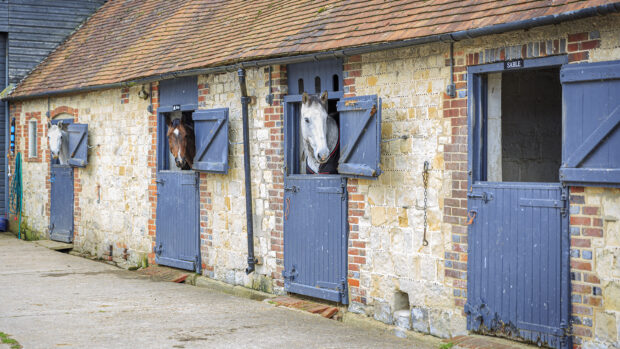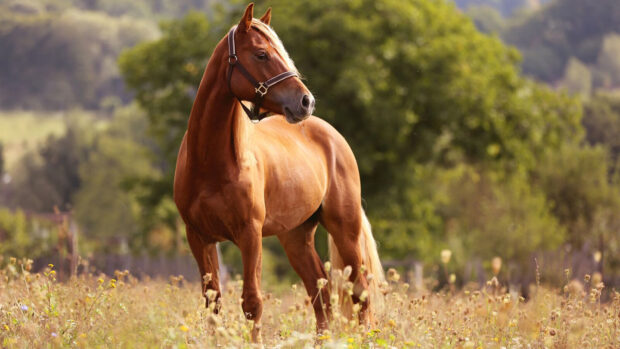 Diet is an important factor in recovery from injury or illness.
Diet is an important factor in recovery from injury or illness.
A period of rest and recuperation is inevitable during your horse or pony’s career, for example, as the result of lameness or colic, or due to an illness or disease such as laminitis, or following surgery.
Diet plays an important role in supporting both recovery from illness and repair of tissues such as bone, muscle or tendons following injury. In order to do this, the diet must provide a number of different nutrients which are needed to support the healing process, or to fight infection or disease.
Protein is an important part of your horse or pony’s diet. Proteins are molecules found in every cell in the body — hormones, enzymes, nerve transmitters, hair, DNA, cell receptors, tendons, cartilage, and muscle to name but a few, and perform an enormous range of roles.
Despite this great complexity, every protein in your horse’s body is made up of an “alphabet” of just 21 building blocks called amino acids. Although your horse is able to make some of these amino acids within his body, the remainder are called essential amino acids, and have to be supplied in the diet. Any deficiency in these essential amino acids can limit protein production in the body. Amino acids are critical building blocks for proteins involved in repair and healing.
During recovery from an injury or infection, or during exercise training, the rate of protein manufacture within your horse’s body may increase. So whether your horse or pony is recuperating on box-rest, or is slowly being brought back into work following an injury, particular care and attention needs to be paid to their diet to fully support their recovery. There are 3 basic rules:
- Provide enough but not too many calories (energy) — this is because your horse’s energy or calorie intake will be lower during box-rest, as they are less active. Even if they have just started back into work, energy intake should ideally be limited to keep them calm and so reduce the risk of further injury.
- Provide a balance of nutrients — this is because nutrients such as fibre, protein and carbohydrates, as well as vitamins and minerals, all aid the healing process by supporting normal digestion, muscle function, immunity and respiratory health.
- Provide a good quality protein source — this is because protein is needed to aid the recovery and repair of body tissues. By providing amino acids in the diet, the raw ingredients for protein synthesis are available to your horse. It may also help limit the amount of muscle mass which is lost during the rest period.
Useful tips
- Feed concentrate feeds on a little and often basis
- While your horse is on box-rest, a concentrate feed that is high in fibre and low in starch is most suitable. This can be continued once exercise starts to be reintroduced.
- Concentrate feeds should be kept small and fed on a little and often basis. This is because small meals allow the digestion of both starch and protein to be maximised in the small intestine. Enzymes, found in the small intestine, are needed to break up the complicated structure of dietary protein in order to absorb its nutrient content, and so feeding “little and often” avoids overloading the digestive capacity of these enzymes.
- Ensure your horse has plenty of high-quality clean forage
- Good quality clean hay or haylage is essential to help maintain your horse’s digestive health and avoiding problems associated with poor quality forage, like respiratory disease. Forage also takes much longer to eat than concentrate feed, and so a high-forage diet will help satisfy the natural chewing behaviours of your horse and avoid boredom, especially during rest and recuperation. The risk of stable vices or stereotypic behaviours such as windsucking and wood chewing may increase if your horse is stabled and fed a high-starch diet with a low level of forage. But while forage is good for behaviour and digestion, it will not provide your horse with an optimum balance of amino acids and this will need to be addressed.
- Supplement your horse’s diet with high quality protein. Some sources of dietary protein are considered to be of a higher quality than others. This is because they contain more of the essential amino acids needed by your horse, especially during times of greater protein requirement. To provide your horse with the best balance of amino acids, you must ensure that the protein in his diet is of good quality and is easily digested in the small intestine. Forage, cereals and cereal by-products, which are commonly found in low energy feeds, all provide your horse with some dietary protein, however, it may not be protein which is high quality and highly digestible. Your horse will equally not derive any amino acids from either starch or oil as neither contains any protein. Therefore a concentrate ration that offers plenty of forage, together with high fibre, low starch, and sometimes high oil, while beneficial in many respects, is unlikely to deliver an optimum level and balance of amino acids. Your horse needs the right balance of amino acids to support healthy tissue growth and repair during recovery and return to work. Equitop Myoplast can be fed alongside this type of ration to supply important and essential amino acids. Equitop Myoplast is a good source of both dietary essential and non-essential amino acids and specifically contains arginine, ornithine, glutamine and leucine, all of which have been shown to be involved in normal healthy repair and recovery processes.
- Provide sufficient antioxidants in the diet. Free radicals are highly biologically active by-products of many normal metabolic processes. During injury and disease, your horse will produce more free radicals, which can contribute to ongoing tissue damage. Antioxidants are thought to help balance against the damaging effects of free radicals on tissues. A complex mixture of antioxidants are found naturally in plants and vegetables. Feed ingredients such as alfalfa, rosehip and ricebran contain a complementary mix of natural antioxidants which can be beneficial to your horse as part of a balanced diet.
What should you do when the level of exercise starts to increase?
Following a period of box-rest, or restricted exercise due to injury, your horse will slowly be returned to full work.
This is a critical phase, as fitness and strength needs to be regained, without causing further damage to the injury in question, which is likely to still be healing. For this reason, you may restrict energy (calorie) intake in order to prevent excessive weight gain and to avoid over exuberance.
But your horse still requires a well-balanced diet that provides plenty of forage and limits the intake of starch. It is also vital that your horse is provided with an adequate level of quality digestible protein. This is because once horses have returned to work and their level of exercise starts to increase, there is an even greater demand for protein to support the increased rate of muscle protein turnover (breakdown and repair) that occurs with exercise. Equitop Myoplast is ideal to supplement your horse’s existing ration providing a high quality and digestible source of protein.
In summary, when your horse undergoes a period of rest and recuperation, or whilst they are being returned to work, they will benefit from plenty of forage, coupled with a low-starch and high-fibre concentrate feed, sometimes with additional oil. Supplementing their ration with Equitop Myoplast delivers a high quality and digestible protein source, providing essential amino acids to support the normal recovery process and muscle turnover when exercise is resumed.
For further information on Equitop Myoplast, visit www.equitop-myoplast.co.uk.
Note: If you believe your horse may be injured or unwell, please seek advice promptly from your veterinary surgeon.
Advice on the use of Equitop Myoplast or other therapies should be sought from your veterinary surgeon.
Further information available from Boehringer Ingelheim Vetmedica, Bracknell, Berkshire, RG12 8YS, UK.
Email: vetmedica.uk@boehringer-ingelheim.com. This is not a veterinary medicine which is subject to authorisation by the Irish Medicines Board. Date of preparation: August 2010. AHD 6443



